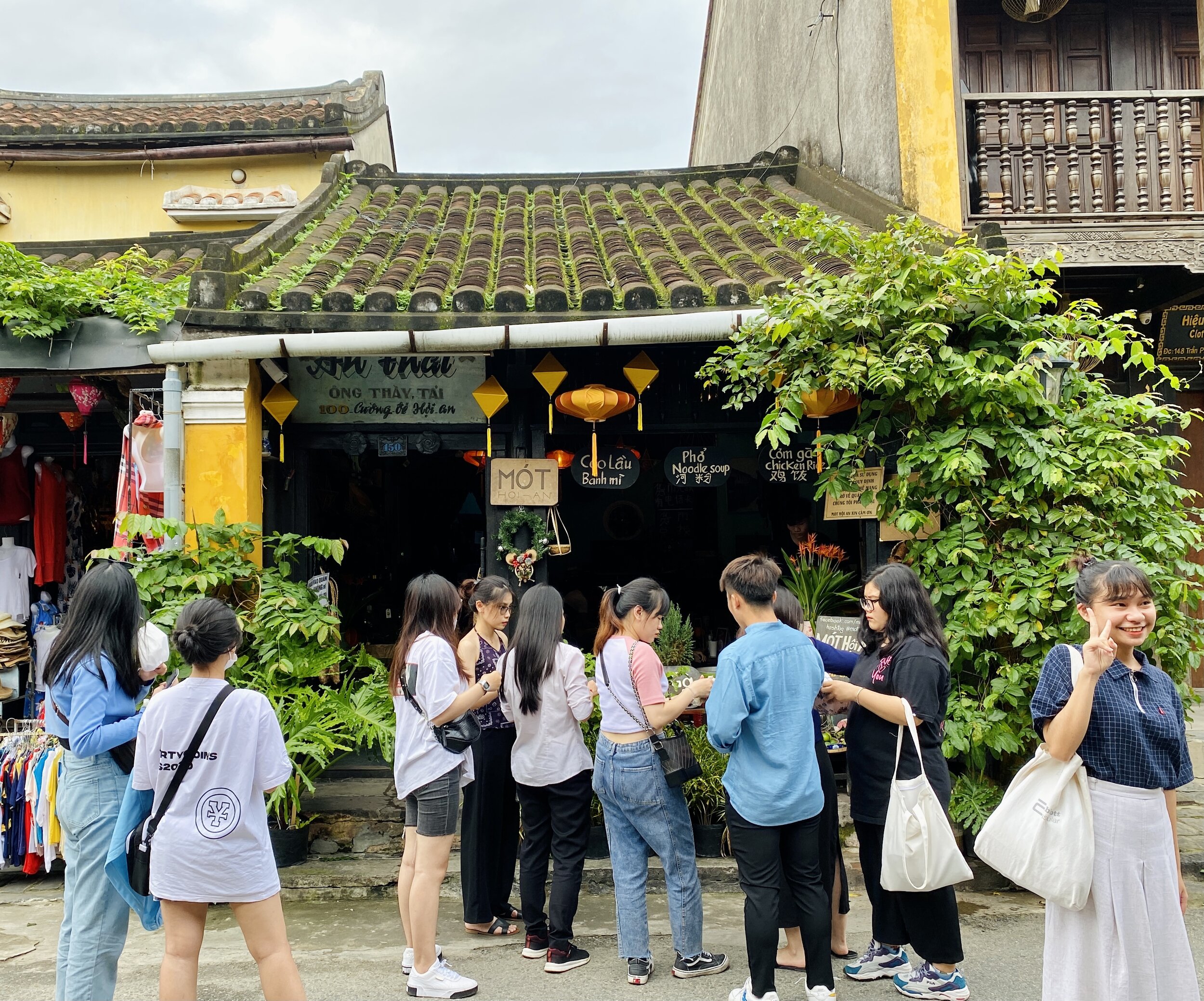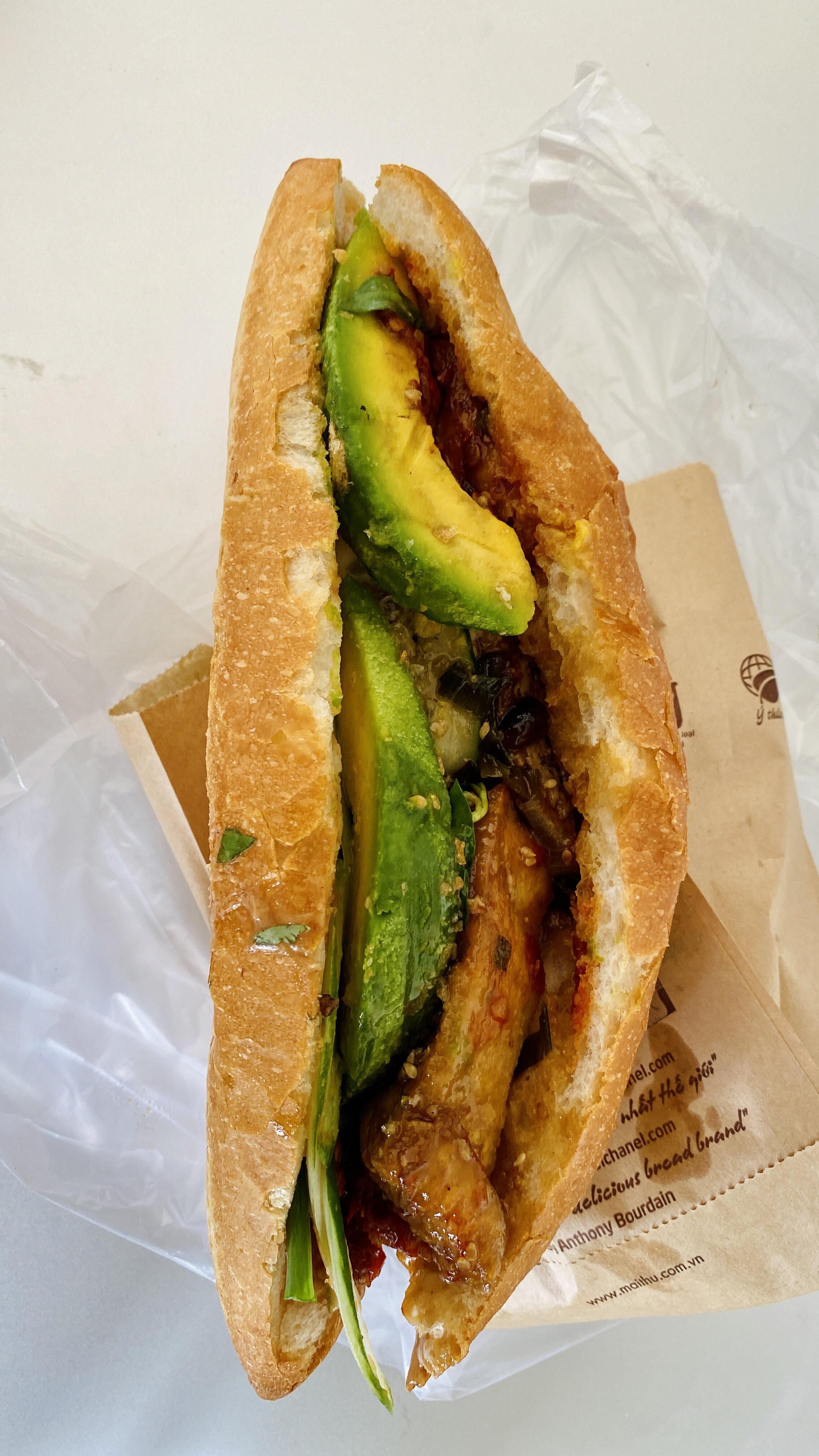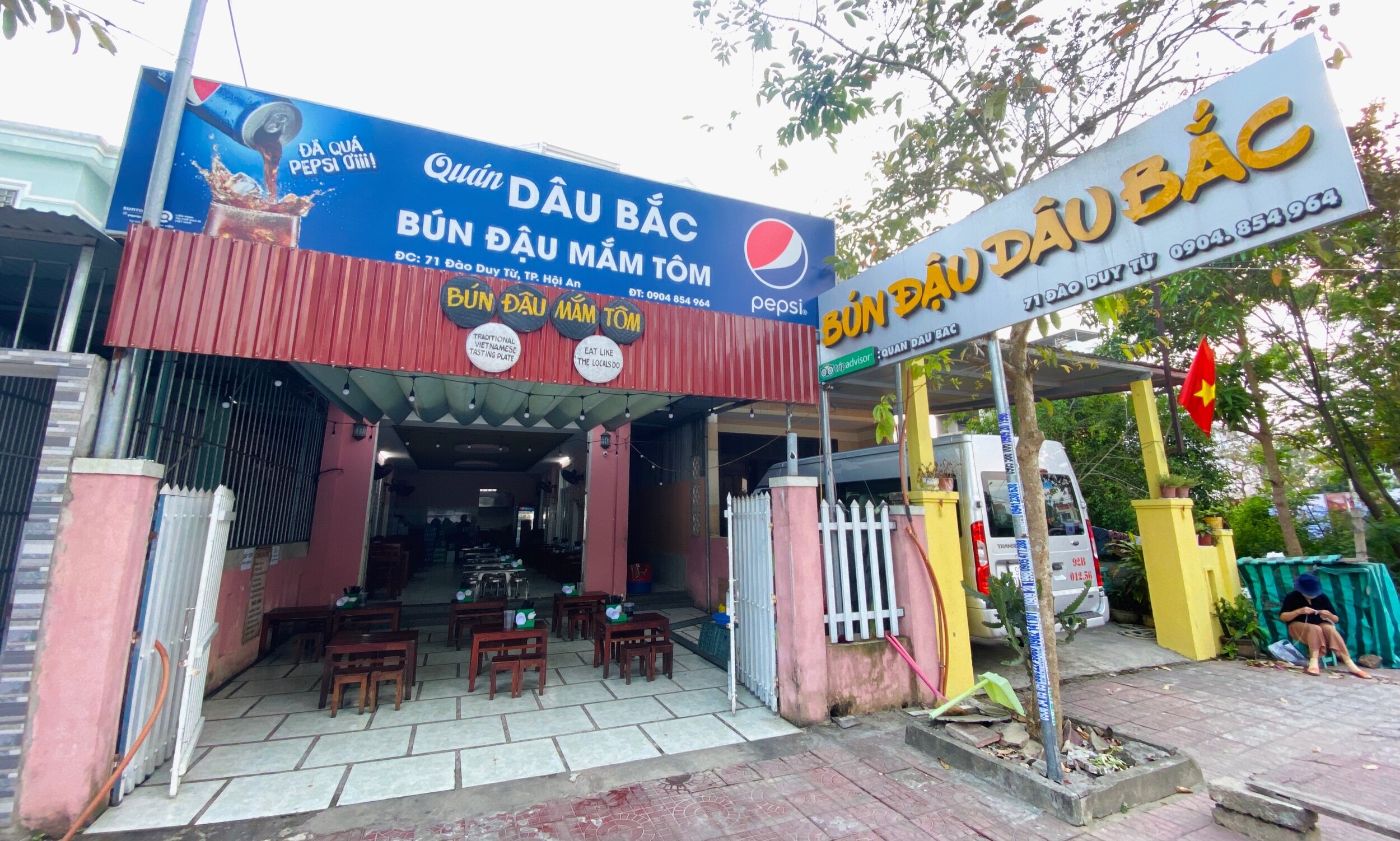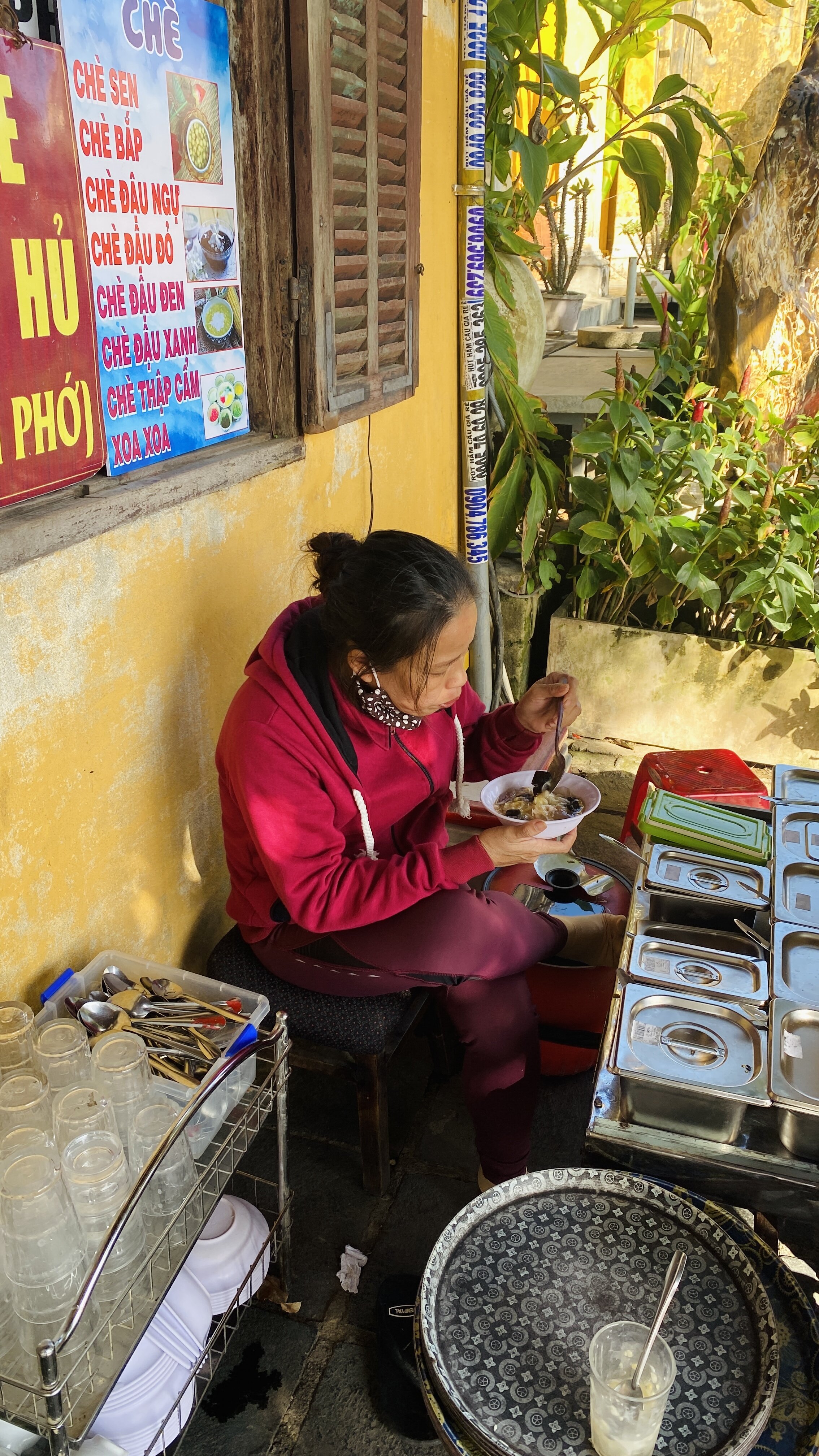Lastly, I MUST mention 2 truly outstanding “Western” restaurants . . .
BEST Italian:
Good Morning Vietnam
I spent two months straight in Hội An, and visited a few times over the course of 7 months. It was enough time to get to know the ladies I was staying with, and I was delighted to find that not only were they Hội An born and bred, they are also intrepid travelers themselves, and one trained as a chef in Saigon! I simply could not have been luckier in sourcing local restaurant recommendations.
I requested restaurants that are old and highly regarded, places popular with locals, their personal favorites, and (most importantly) true Vietnamese cuisine with strong emphasis on local specialities.
BEST ONE STOP SHOP:
Mót Hội An
150 Trần Phú, Old Town
The local food at this tiny restaurant is excellent and cheap, and the place is always packed. Their menu has all of Hoi An’s greatest hits: bánh mì, cao lầu, thịt nướng, cơm gà, bánh vạc bông hồng trắng, hoành thánh chiên, and mì quảng are all on the menu; plus phờ, spring rolls, and wonton soup.
Their popularity, however, stems from the traditional Chinese medicinal drink sold here for just 12,000 dong. Sometimes called lemonade, sometimes tea, the bare bones ingredients for chanh sả (which literally translates as lemongrass lime) are lime, lemongrass, cinnamon, ginger and honey. At Mót they incorporate several additional ingredients according to an old family recipe, originally formulated to soothe digestive ailments. It’s incredibly refreshing and delicious!
This restaurant is also smack in the middle of the Old Town, the most centrally located of any on this list. If I only had one day in Hoi An, I would just come here and order one of everything!
BEST Bánh Mì:
Bánh Mì Phượng
2b Phan Chu Trinh, old town
Obviously, bánh mì is an ubiquitous food that didn’t originate in Hội An. Equally obviously, it tends to be a street food rather than a restaurant food. Yet, foodies seem to agree the best bánh mi in the country comes from two shops here, this being the more famous.
The back of their bags quote the late, great Anthony Bourdain as saying: “The world’s best delicious bread brand” . . . which he obviously didn’t, being a native English speaker. I’m sure whatever he did say was positive though, because the bánh mì here is fantastic, and the scene aired on his Travel Channel show. I probably saw it and forgot it myself, years before I ever imagined coming to Vietnam.
I always order the vegetarian (chay) because it’s so damn delicious: tofu marinated in local soy sauce (Vietnamese soy sauce is sweet, yellow/brown and thick, not at all like the Japanese sort imported into the US) then lightly fried; avocado slices; peanut pâté, sautéed eggplant; a stalk or two of rocket; a leaf or two of lettuce; chili sauce; and chili jam; all on a perfect Việt baguette (crispy but not tooth-cracking like its Parisian ancestor).
Lunch here is a truly class-free society moment: jetsetters, schoolboys, street cleaners, and office ladies all queue up. They have a seating area, but sometimes the owner’s husband is the only one there, chainsmoking and people watching, so I tend to order through Grab.
ALSO THE BEST Bánh Mì:
Madam Khánh
115 Trần Cao Vân, old townish
Foodies are always pitting Phượng and the Madam against each other in some sort of perpetual bread battle. How dare they! They are both superb, though it appears the Madam’s daughter does the cooking these days. My personal favorite bánh mì of all time is Madam Khánh’s bánh mì trứng chiên. Pâté, slightly runny fried eggs, chili sauce and cucumber (on another great baguette) make this a breakfast favorite. I love it with their fresh blueberry juice.
The vibes in the seating area are way less hectic than at Phượng’s; it’s farther away from the tourist area, so there are more motorbike pickups than seated customers. Around 1pm is nap time and the lights go out, but you are welcome to sleep sitting up across two chairs with the fam if you need more time to digest.
DON’T BOTHER:
Bale Well
45 Ngõ 51 Trần Hưng Đạo, old townish
Every other restaurant on this street is called Bá Lễ Well something or other, referring to the ancient well behind Bá Lễ’s house. Though there are 80+ wells in Hội An, this particular well is famous for a few reasons. First, it is truly ancient, constructed by the Champa in the 10th century. Also, it’s never run dry, and so has been the go-to well for locals, soldiers and sailors for hundreds of years; when you drink a cup of well water, you are presumably tasting a bit of history. Lastly, it’s mineral richness (particularly aluminum) gives the water a slightly sweet taste that is considered the make or break ingredient for the local specialty, cao lầu.
Bá Lễ is 90 odd years old, but still kicking around and locally famous. He maintains the well and that’s why it’s named after him. Another local elder, Nguyễn Dương, has delivered the well water to local restaurants and households since 1975, so people my age grew up on this well water. I’ve had tasteless cao lầu and very tasty cao lầu, and now I wonder if the well water really did make the difference!
At any rate, this particular restaurant is not known for its cao lầu, but for the local styles of bánh xèo and thịt nướng. Both are foods that are served nationally, but with distinct regional differences, so these are the central coast versions. I believe this place is popular because they have a set menu with displayed prices, provide all the sauce and veggie extras, and demonstrate to foreigners how to assemble the rolls properly. It was honestly nothing to write home about. I’ve had better bánh xèo from street vendors and found the thịt nướng slightly revolting, but that could be because I’m already not a pork person, and this I would barely call pork, it was more like strips of burnt pork fat.
For reference, bánh xèo are fermented rice pancakes colored yellow with turmeric. The Hội An version is relatively small; you get 3-4 pancakes where in Saigon you’d have the same amount of food in one giant pancake. The fillings also vary regionally and by taste; here there’s typically a lot of bean sprouts, a small square of bacon and a whole (shell, legs, and tail still on) grilled shrimp in each pancake. You can eat it as is, or open it up and pile on fresh and pickled veggies (usually lettuce, mint, cabbage, papaya, carrots, cassava, cucumbers), chili jam, fish sauce, mint, even peanuts, and re-roll in rice paper. Bale Well didn’t include the bacon, so despite all the fresh veg it was relatively bland, lacking the salty/sweet contrast of its competitors. It was also a bit spongy inside, not fried crispy at all, which again takes something away from the best versions of bánh xèo I’ve had.
Thịt nướng just means pork meat, and refers to grilled fatty pork. It’s assembled in much the same way, rolled in lettuce leaves and rice paper wrappers, having been dressed with veg and sauce. It’s the sibling of bún thịt nướng, which is the same thing over white rice vermicelli-like noodles, and the cousin of bún chả, the Hanoian iteration with minced pork meatballs and a soup base. Just the smell of this on people can make me feel nauseous, so for me it was a YOLO fail. Your mileage may vary!
BEST Bánh Xèo & Thịt Nướng:
Sông Hoài
An Hội island
There are only four items on the menu here; all dishes are 35,000 dong and all are meant to be shared. I found the bánh xèo and thịt nướng here to be far superior. The bánh xèo was still a bit oily for my taste, but the least greasy out of all the places I tried. They also used the highest quality pork of any place so far, alternating between squares of melted bacon type cuts and tender, soft strips. The thịt nướng here was likewise the best I’ve eaten for the same reason: the pork was simply higher quality and cooked with more care, and therefore tastier. There’s also an incredibly cute bulldog here, whose presence is guaranteed to cheer you up!
BEST Mì Quảng:
Mì Quảng Bích
272 Hùng Vương, outskirts
Mì Quảng is named for Quảng Nam province, so it’s a true local specialty (as opposed to a local take on a common food). Mì Quảng is composed of thick rice noodles in a savory broth made with garlic, shallots, black pepper, fish sauce and turmeric, in addition to the local herb infusion found in all Việt noodle soups.
The added protein varies, but in Hội An, if no request is made, you can expect thinly sliced pork or whole shrimp, topped with green onion and peanuts. A deluxe version will have both, and/or hard boiled quail eggs. Some places allow special orders for chicken, but it’s not really the best in this dish. As with all other Việt noodle soups, mint, lettuce, bean sprouts, limes, chilis, and fish sauce are served on the side and can be added to taste. It’s also served with bánh tráng mè (toasted sesame rice crackers) that you can break up and add for crunch. Growing up with Stella D’Oro breadsticks, that toasted sesame taste resonates with me!
Mì Quảng Bích’s recipe is absolutely delicious. Her place is very local yokel, the kind of place where you get the impression the young kids and ancient ladies staring at you may never have seen a foreigner up close and personal before. From the center of the old town, it’s a 40-50 minute walk along the river; it’s nice on a temperate day but I had trouble getting a Grab to drive me back. She only serves two dishes, mì quảng and cao lầu, and her mì quảng has shrimp, thinly sliced roasted pork and quail eggs, and tastes very fresh and slightly spicy. It’s super busy at breakfast and lunchtime, and I would happily go back any time I’m out that way.
I WON’T BE BACK:
Mì Quảng Ông Hai
6A Trương Minh Lượng, old town
Locals and bloggers alike agree that Mì Quảng Ông Hai is the place in Hội An to have this dish. Unfortunately, I was refused service there. I’d like to believe it was a terrible misunderstanding, but it seemed to be xenophobia; they had recent reviews posted from Vietnamese people, and people eating outside, but turned me away one Wednesday night. I thought I just got there too late . . . a lot of mom and pop shops around here close at 8. So I went back early Friday evening, and again there looked to be people eating outside, and again I was told they were closed. I asked if they’d be open on Monday and was told no, they’re closed “because of coronavirus.” So . . . they’re open for Vietnamese people but closed to me, “because of coronavirus.”
To be clear, borders closed March 22nd and I was trying to eat on November 17th. One would assume I live here, not that I somehow illegally entered the country within the past nine months and have been spreading deadly, yet unreported disease ever since. No one in Vietnam has tested positive since September, and the last positive case was community transmission between Vietnamese people. The only people allowed in the country are Vietnamese nationals, so the only people importing coronavirus into the country are Vietnamese nationals. Brutal question: do they really think I’ll make them sick, because they are old/uninformed/don’t understand . . . or have they always loved tourism money while still resenting tourists, or white people, or Americans, or whatever I look like to them, and this is their rare opportunity to say no to someone like me, with fewer of us around lately?
More importantly, is their food worth all that? I’LL NEVER KNOW BECAUSE I WON’T BE BACK.
BEST Hến Trộn with Bánh Đập
. . . BUT DON’T SAY I DIDN’T WARN YOU:
Quán Ăn Bến Tre
Xuyên Trung, Cẩm Nam island
This place is known for three things: hến trộn, bánh đập, and scamming tourists. Yet it remains the go-to place, frequented by locals because it’s a third generation business that’s been serving the island’s signature dish for over 50 years. There are many google reviews mentioning the scam: first the proprietress hands you a professionally printed English menu where the price is double the prices on the Vietnamese sign; later, when she presents you the bill, it’s again somehow more than you were expecting. I believe I paid $12 for the clams, smashing rice paper and a single beer, which by local standards is absolutely ludicrous. I don’t always mind being scammed; for example,15,000 dong (65 cents) doesn’t matter much to me, but can really help out a street fruit seller..
This lady, on the other hand, has clearly inherited and expanded a longstanding family business, and had the audacity to debate me on Trump (her for and me against, obviously). I explained I disliked him for many reasons, but primarily the diabolical wealth transfer executed during the pandemic. FYI, the Fed printed exponentially more money than ever before in history, so billionaires could double and triple their net worths while the average American received a single $1200 check many months into the crisis, or never received one at all, because this type of relief is only available to people with permanent addresses and bank accounts in good standing, who also filed their taxes properly in 2019 . . . in other words, cruelly excluding those who need help the most.
This lady posited that according to her sister in Texas, the US government was sending weekly relief checks. I explained that only if you already qualified for unemployment payments, you got an extra $600 per week for a few months, but that ended 5 months ago. Also, due to lockdowns and backlogs at already poorly run state agencies, many people were unfairly denied, or made to wait for weeks or months for their first payment, or sent debit cards to old addresses and just never got paid. When filing my 2020 taxes I was informed by New York State that I had received relief funds that must be declared, when I never received a cent. And again, this method excludes the neediest people in the country, those who didn’t qualify for unemployment and were already struggling before the pandemic.
This is where the conversation went left, with the restaurant owner repeatedly insisting her sister told her it’s $1200 every month and they’re still getting it thanks to Trump. We went back and forth several times, with me responding that it’s just not the case (thinking that perhaps she didn’t understand me due to the language barrier, or that she had misunderstood her sister), and her suggesting I was either ignorant because I was not physically present in the US, or just not believing Trump was doing something good because I didn’t like him.
And this was all before I had touched the food! I found myself slightly hungry, more than a little annoyed, and wondering: why is she asking me questions when she clearly has answers she likes? Why does she need to “win” a casual chat with an American, also a paying customer, about America? Does Trump pay her bills as well as her sister’s? But of course, an argumentative scammer with no time for facts would like Trump.
Back to the food! Hến trộn is tiny river clams sautéed with mint, onion, peanuts, and perhaps some spices or fish sauce. It’s served with bánh đập, which is a super thin three layer rice cake: the outer layers are crisp, but the inner layer is left soft and translucent. You crack a stack of it into pieces with your palm before dipping it into an ultra concentrated local fish sauce, and scooping up the clams with it. The fish sauce is strong enough that it’s served to foreigners with soy sauce to dilute as necessary, because many people can’t stomach ít.
The rice crackers were fun, the fish sauce really was a bit putrid, and the clams were just OK. To be clear, I love clams. As a partially Sicilian New Yorker, clams are in my comfort zone: straight out of the shell in their own liquor; raw with a dab of ketchup; spaghetti alle vongole, oregenata at restaurants . . . we even had Clamato juice in the fridge growing up (which sounds gross until you learn anchovy paste exists). Maybe I need to try a different restaurant, maybe I just prefer my own way over the Vietnamese version, same as snails. I thought they could use a little garlic ;)
BEST Cao Lầu:
Trung Bắc Restaurant
87 Trần Phú, old town
Cao lầu is Hội An‘s most iconic dish, and making it is quite involved. The water used to make the noodles must come from the Bá Lễ well; those noodles are then soaked in lye leached from the ashes of herbs grown on Cham Island. The complicated process of making the noodles gives them a slightly chewy texture, faintly smoky flavor, and yellow color. The typical topping is sliced char siu pork, bean sprouts, onions, lettuce, and various herbs, with just enough pork broth poured over top to wet the noodles, plus deep fried squares of the noodle dough.
This was unexpectedly delicious. We know I’m not a pork person and the first bite was hard for me, but this was melt-in-your mouth good. The noodles were delicious, the taste was simultaneously fresh, savory and warming. I truly enjoyed it. I also have no doubt that theirs is a wholly authentic version; the only people there were me and 4 really old local dudes taking a break from their card game on the stoop next door. We often hear the words subtle, fresh, and nuanced in reference to Vietnamese cuisine; when done poorly it’s painfully bland, but when done well, magic can happen, and this was it.
THE LITERAL ONE AND ONLY White Rose Dumpling (Bánh Vạc Bông Hồng Trắng)
& Wonton (Hoành Thánh Chiên) PLACE:
White Rose Restaurant
(Nhà Hàng Bông Hồng Trắng)
533 Đ. Hai Bà Trưng, old townish
This restaurant only makes two dishes: bánh vạc bông hồng trắng and hoành thánh chiên.
Bánh vạc bông hồng trắng, or “white rose dumplings”, are more than a local dish, they are a recipe closely guarded by a single family that’s been manufacturing them for generations. They own this restaurant, and they supply all the other restaurants in town. So, no matter where you eat them, this is where they came from.
There are no roses in the dough; the name comes from their resembling a fully bloomed flower when cooked, and was supposedly bestowed by a French patron in the colonial era. The dough is prepared with water from the Bá Lễ well, and the filling is a proprietary shrimp paste. They also include a few with minced veggie filling for variety. Fried onions are sprinkled on top,and the dipping sauce is a bit sweet, made with lemon juice, sugar, chilis, and shrimp broth. These are subtle and delicious!
Hoành thánh chiên is often lumped into the “Hoi An pizza” category by bloggers, but it’s nothing like bánh tráng nướng. It’s actually the same white rose dumplings, but deep fried into wontons and topped with a sweetened ratatouille of tomatoes, oyster mushrooms, white onions, tiny bits of mango and grilled shrimp. In the restaurant it’s served opened faced and gets too soggy for my liking. I prefer to order it to go and put the ratatouille in a bowl, breaking up the wontons and dipping them in like chips.
Both dishes are simple and satisfying, as long as you don’t mind slightly sweet food.
BEST Cơm Gà:
Cơm Gà Bà Buội
22 Phan Chu Trinh, old towN
The history of cơm gà is interesting: in the 17th and 18th centuries, Hội An was Vietnam’s largest trading port, and many Chinese (and a few Japanese) families moved to the town and province for business reasons. With them came their cuisine, and some of it stuck around. This dish hails from Hainan island, and uses their “white cutting” method for preparing chicken: first boiling it in herb and onion infused water, then shredding it and dressing it lightly in salt, pepper and lime juice. The rice is cooked in the resulting chicken broth, sometimes with garlic or shallots added. The meal is served with a small cup of the chicken broth, a small dish of shredded papaya and carrots, herbs on the side, and if requested, a small bowl of cooked innards.
With such a simple meal, the highest quality ingredients and the right blend of herbs is everything. Bad cơm gà is bland verging on inedible; great cơm gà is still quite boring in my opinion, but refreshing in its simplicity, the kind of food I would eat if I had a sick stomach and needed to cut sugar, spice and grease. That’s probably why Vietnamese people are usually thinner than Westerners, the mentality isn’t about seeing everyday food as an opportunity to overindulge, but as a tool to stay energized.
This restaurant has been the go-to place for the dish for over 50 years, and theirs is the best I had. They also serve corn milk and black sesame milk if you need an exotic hit of carbs.
ALSO THE BEST Cơm Gà:
Cơm Gà Bà Hồ
16 phan chu trinh, old town
In business since 1969 (side note: wow what a tough year to hang out a shingle in Vietnam), this restaurant has their own well, and the cơm gà is cooked by a granny. Who could ask for more? It will never be my favorite dish (too boring) but the version served here is tasty and authentic. Of particularly good quality was the broth; it was incredibly familiar to me, tasting just like the chicken broth at old school Chinatown restaurants. It makes sense given the southern coastal Chinese diaspora of 200 years ago, and it was wonderful to discover that these dishes I’ve eaten literally across the world from each other are so true to the ancient original.
BEST Bánh Bèo:
Bánh Bèo Bà Mỹ
Nguyễn Thị Minh Khai, old town
Bánh bèo hails from slightly further north in Huế, but the two cities were closely entwined as long as Hội An was a primary port, bringing in luxury imports for consumption at the royal court. The dish consists of glutinous rice and tapioca flour shells, topped with with a bit of dried shrimp and onions, pork skin or sliced cinnamon sausage, and topped with a sweet nước mắm pha dipping sauce. This is more of a snack than a meal; it’s best shared with friends and washed down with iced tea. It’s a bit bland for me; I find myself filling the cups with the sweet dipping sauce. However, this restaurant has been serving them up for over 20 years, so if you’d like to try them, it’s a great choice.
BEST Bún Đậu Mắm Tôm:
Quán Dâu Bắc
71 Đào Duy Từ, old townish
Bún đậu mắm tôm is not for everyone! The central flavor of the dish comes from extremely pungent fermented shrimp paste, served with Vietnamese type salad greens, sliced cucumber, fried tofu, fried and boiled pork belly, fried spam, and fried new rice cakes. If you can’t tell from the preponderance of fried elements, this is kind of a late-night-drinking-with-friends food. The dish originated in Hanoi, but this is the wildly popular central coast version.
Run by two ancient ladies and an English fluent daughter, a cadre of elderly local women hang out here in the daytime, and invited me to snack on the tiniest snails ever with them. Fun!
































































































